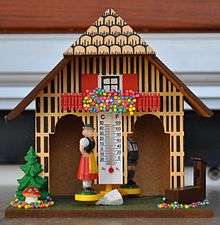Weather house

A weather house is a folk art device in the shape of a small German or Alpine chalet that indicates the weather. A typical weather house has two doors side by side. The left side has a girl or woman, the right side a boy or man. The female figure comes out of the house when the weather is sunny and dry, while the male comes out to indicate rain.
Description

In fact, a weather house functions as a hygrometer embellished by folk art. The male and female figures ride on a balance bar, which is suspended by a piece of catgut or hair. The gut relaxes or shrinks based on the humidity in the surrounding air, relaxing when the air is wet and tensing when the air is dry. This action swings one figure or the other out of the house depending on the humidity.[1]
Weather houses are associated in the popular mind with Austria, Germany or Switzerland, and are often decorated in the style of a cuckoo clock. Many weather houses also bear a small thermometer on the part between the two doors that conceals the gut suspension, and many also contain a piggy bank. In contrast, the term "weather house" in the United States refers to buildings built by the U. S. Signal Service and then the U. S. Weather Bureau to house the instruments and Chief Weather Observers so that they could do their job. For more information see the U.S. Weather Bureau.
Cultural influence
A one-act English comic opera called Weather or No, about the male and female figures in a weather house falling in love, became popular when it was played as a companion piece to The Mikado in 1896-97.
